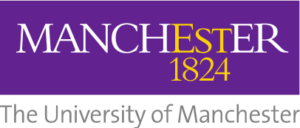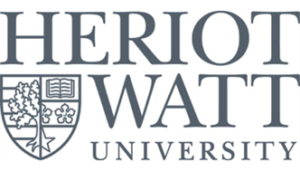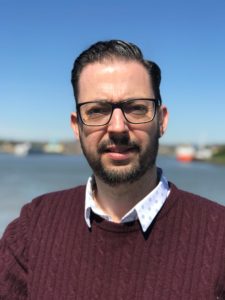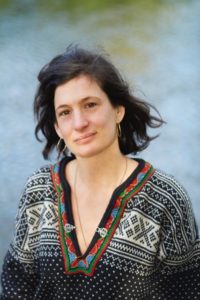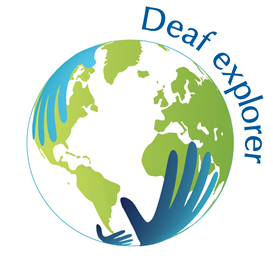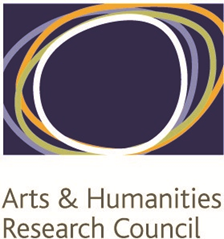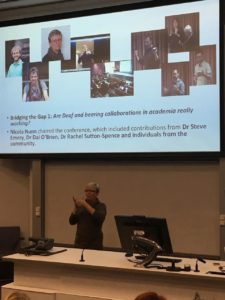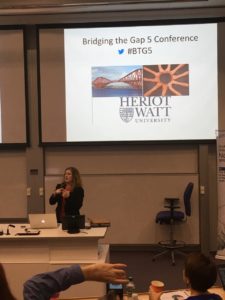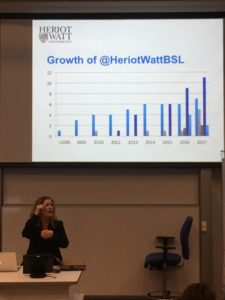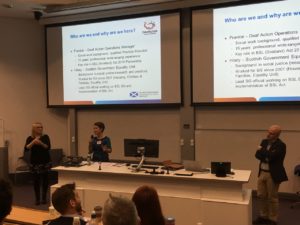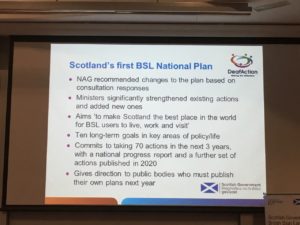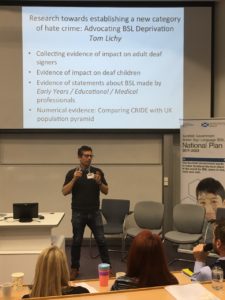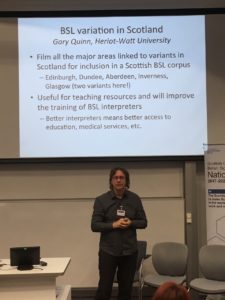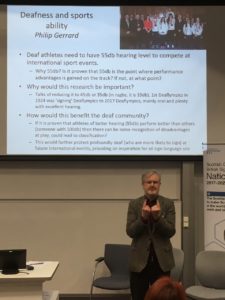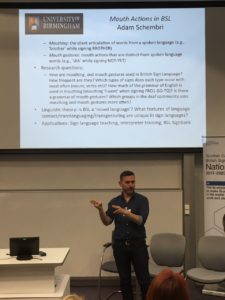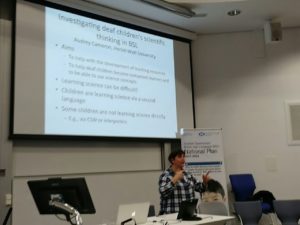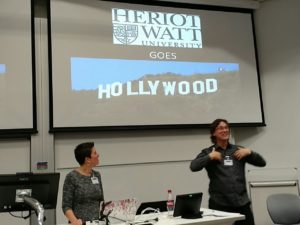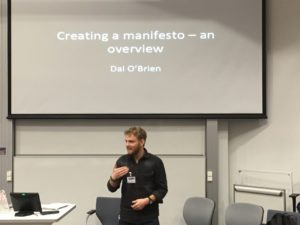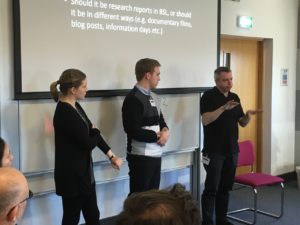By Audrey Cameron & Jemina Napier
In this blogpost Audrey Cameron and Jemina Napier provide an update on the work that’s been done on the DESIGNS Project (promoting access in employment for deaf people) since our last blog/vlog post in December 2017.
Interviews with interpreters working in employment settings and employers have now been completed and analysis of the data has begun. We will be presenting some of the early findings at the next DESIGNS community information event in Berlin in June. On the 14th June, from 6:30pm, we’ll be live streaming another information sharing event via Facebook with presentations from Audrey Cameron, Jemina Napier and PhD students Emmy Kauling and Mette Sommer.
We are grateful to Vercida and to members of the DESIGNS project advisory group for helping us identify employers willing to participate in the research and our thanks also go to those employers who agreed to be interviewed about their experiences of working with deaf sign language users.
We would also like to extend our gratitude to all those who have given up their time to contribute to the project.
The DESIGNS project runs until June 2019 – the next update is due after the summer.
Below is a transcript of the update in BSL.
Jemina: We’re here today to give you a bit of an update on the work the two of us have been doing on the DESIGNS Project since December – was it December?
Audrey: … before Christmas, yes…
Jemina: … so we want to tell you what we’ve been doing over the past 4…?
Audrey: … I think it’s been 5…
Jemina: … 5 months.
Audrey: Well, the time has really flown by since it all started over 6 months ago.
So let me update you on a few things. As mentioned in a previous blogpost, we’ve been interviewing people from three different groups – deaf people, interpreters and employers. Well that’s now been done and we’ve collected some amazing data – it’s good isn’t it, Jemina?
Jemina: Yes – there’s a lot of it!
Audrey: The next thing is to do the analysis and start identifying the key themes – whether they’re the same amongst all three groups, what the difficulties or positives have been; what the differences might be, so that’s what we’re working on at the moment.
Jemina: We will be giving you more information about what we’ve found as we go on and at the end of this Vlog we’ll be telling you about one way you can find out more about those findings!
Audrey: Yes!
We want to thank both our Advisory Group and Vercida for helping us to identify employers who were willing to be interviewed for the project – without them it would have been difficult for us to find them and ask about their experiences, so again thanks to them.
Jemina: Yes… we’ve also had an Advisory Group meeting, do you want to talk about that?
Audrey: Last January we had a meeting with, was it 6 Members of the advisory group? It felt a bit strange, we had the meeting online so they all appeared in boxes on the screen and we were signing to one another via Skype, but it worked well and we have another meeting like that in June. The Advisory Group members are from all over the UK, which why we have to use Skype, but like I say, it was good meeting.
Jemina: The Advisory Group members all have experience of working with deaf people in employment or working in an advisory capacity with disabled people in employment and we specifically invited them on to the group to help us get a UK wide perspective.
Audrey: Yes and that’s been really good.
Jemina: As part of this project we arrange regular Community Information Events to let people know what’s happening in the project and to explain what’s involved. That’s really important, especially for the Deaf Community but anyone who’s interested, is welcome to come along. So far last year we had two of these – the very first one was in Dublin; the second was here in Edinburgh at Heriot Watt University, that was June last year, and then last January we had one in Bruges in Belgium. The fourth will be in Berlin when the whole project team will come together and we’ll have another community information event which usually includes presentations about what’s going on in the project plus a number of other things. You can still see last year’s event in Edinburgh – it was live streamed and recorded, so if you want to go back you can take a look at it. We also did something in Edinburgh at Deaf Action and thank you to them for hosting that. We had staff there from HW and PhD students who gave presentations about their research topics. Our fourth year students got an opportunity to practise their interpreting skills – they’re in their final year and nearly at the end of the course, so they got in some practise – Audrey, you gave a presentation about the DESIGNS Project.
Audrey: It was good – members of the deaf community were asking questions and will be keen to know more once we’ve finished the project – so that’s exciting.
Jemina: So what’s the plan for the next few months?
Audrey: Next it’s Liverpool for the Deaf Business Academy awards event where I’ve been invited to deliver a presentation about this project and as part that there’s an award ceremony for the best businesses – I’m looking forward to that, so that’s Liverpool in June. Then in September there’s the EFSLI (European Forum of Sign Language Interpreters) conference and I’ll be presenting along with our other partners in the project from Germany and Ireland, so that’ll be good. We’re also doing an ASLI webinar where Jemina will be presenting online to interpreters – that’s in September and we’ll let you know more about that nearer the time.
Jemina: Oh, and one exciting thing to mention that we’ve got planned, is for this June on the 14th, we’ll be having a live streamed Community Information Event. It’ll be here but we’ve decided, rather than have people come to us, we’ll live stream it so that’ll give people from around the UK more of an opportunity to see it. It’s on the 14th June at 6:30pm in the evening. There’s already a Facebook Event/invitation page so you can click on that to let us know if you want to join in. We’ll be live streaming via Facebook with four presenters, the two of us will be revealing some of the findings from the DESIGNS Project from the interviews with interpreters, deaf people and employers and what they said the main themes were, so we’ll be going in to more depth about the findings. Plus we have two other people – one is a PhD student, Emmy Kauling – her PhD is linked to deaf professionals working with interpreters, which is a perfect fit for the DESIGNS Project. The other is a PhD student, Mette Sommer who is deaf and she’s doing research into deaf people who set up their own businesses, how they felt about it, what their experiences have been like and what motivated them to go it alone? And again that’s a perfect fit with the DESIGNS Project, which is why we asked her to give a presentation. So the four of us will be presenting for about 15 minutes each and then you’ll have an opportunity to ask questions via Twitter, or you can watch via FB and the send in comments/questions and we’ll both respond so I hope you’ll join us and be watching on June 14th.
Audrey: We do want your feedback on the 14th – what you think of the findings; also maybe you can add something extra from your own experience that we could explore further with you.
Jemina: This project runs up until June of next year 2019 which means as we go on there will be further updates like this one, letting you know what’s happening. Plus as part of the project there’s an expectation that we’ll produce more training resources for interpreters, deaf people and employers which means there will be more happening right through until the June when we finish.
We want to say a huge thanks to the Advisory Group and Vercida and others who helped us find people to participate in this research project and also a big thanks to everyone who agreed to be interviewed either as part of a group, or one to one – we’ve been so touched by the time they’ve taken to tell about their experiences – it’s been really valuable and much appreciated, so thank you to you all!
Audrey: I’m sure this will help us to make big changes to employment for deaf people – fingers crossed!

